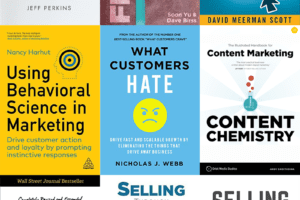Episode 95 of Yes, and Marketing
Memetic content is good content, because people share memetic content.
Memetic content gets people thinking, “This is something that I have thought about or felt before, and now this person is putting it into words for me.” This is why memes are, well, memes.
Get a masterclass in memetic content from Joe Lazauskas AKA Lazer in this episode of Yes, and Marketing. Joe was previously the VP of Marketing at Contently, is the bestselling author of The Storytelling Edge, and currently leads content at A. Team, the world’s first on-demand team formation platform for instantly creating expert tech teams.
Joe knows content inside and out, and this interview covers a lot:
- How to think about content for startups in an entirely new space
- The biggest changes looming on the content marketing horizon
- Why creativity and empathy in content rely on brain chemistry
- How to build content that fuels a community
- Which content ideas make distribution easier
Listen to the full conversation above or read on for the highlights. You can also view video clips from this and all our episodes on our show page.
???? Who is Joe Lazauskas?
Name: Joe Lazauskas
What he does: Head of Content at A.Team and author of The Storytelling Edge. Former VP of Marketing at Contently.
Find Joe on the web: A.Team | Joe’s website | LinkedIn | Twitter
Get smart: “A big quality of good content is that it’s almost memetic in nature. When people read it, you get this sense of, ‘This is something that I have thought about or felt before, and now this person is putting it into words for me.’”
???? Top Takeaway
Good content is memetic
“I think a big quality of good content is that it’s almost memetic in nature,” Joe says. “When people read it, you get this sense of, ‘This is something that I have thought about or felt before, and now this person is putting it into words for me.’ When people have that experience of reading or watching or looking at something, they’re much more likely to share it.”
Joe explains that memes aren’t just funny pictures you scroll by, chuckling, on social media. “A meme is any piece of content that gives you that feeling of feeling seen and heard and like what you really believe is being validated and echoed.”
When we feel validated by a piece of content—when we feel like it understands our perspective, our emotions, and our pain points—it’s much more likely to cause us to take action. We’re also more likely to share it because in doing so, we’re sharing a piece of our own experience with others.
How can we create content that validates?
By understanding our audience. “You have to deeply understand your audience,” Joe explains. “That to me is the most central part of a content strategy.” By understanding our audience, we can develop empathy, and through empathy, we can create content that resonates with their experience.
????Episode Highlights
Read verbatim excerpts from our interview with Joe Lazauskas.
His most successful piece of content
“In terms of hard ROI numbers, I would say it was Contently Quarterly, which was a really awesome, glossy print mag that we put out for a long time at Contently. We would send it to our customers, but also to a target list of CMOs and marketing execs that we wanted to reach.
Being a content marketing company and putting out a print mag might seem a little bit weird, but in a world where there’s endless digital media, a print mag actually really stood out. It was beautiful. We had a lot of funny elements to it. We treated it like a pure editorial product.
…That consistently would drive over a million dollars in ROI, generally like 15 to 20x ROI in terms of the pipeline.”
Don’t separate content from your marketing
“We definitely went through a period where brands were excited about content marketing. Everyone was like, ‘I want to be like Red Bull, I want to be like Amex’—but they treated content marketing as these separate little projects that were outside of the rest of their marketing org. They separated content marketing as a separate thing, which it really shouldn’t be. Content and storytelling is just a great way to engage and build trust with your target audience across any touchpoint across the customer journey.”
Distribution + concept + structure
“You also have to think about like the way in which you distribute it to people. Is it something that they’re just going to toss right in the recycling bin? Or is it something that feels weighty and valuable?
And across any type of content product, whether it’s a podcast, etc., you need a concept that’s actually truly original or that delivers real value to people, and you need to structure it in a way that’s actually unique—that’s a unique show format and not something that you can get anywhere else. I think those are principles that apply to whatever you’re creating.”
The brain chemistry behind creativity ????
“Great content comes from a place of deep empathy for your audience. That’s what sparks your creativity the most because empathy triggers the production of oxytocin, which is greatly linked with the production of dopamine, and dopamine is that thing our brain loves that makes us our most creative self. Just ask all of the incredibly drunk writers from the twenties as to why that lubricant helped a little bit: because it helps produce dopamine.
If you don’t develop that deep sense of your audience, where you’ve sort of molded this person that you are creating for that you know really deeply, that you can hear in your head, that you can feel—I think it’s really hard to create your best content.
Don’t love the work? Don’t do it.
“Everyone wants to hack their way to a successful content program. You just have to put in the work and you have to enjoy that work. If you don’t enjoy the work of creating, you should probably do something else. Do performance marketing or go into sales, even. Sales is all storytelling and pays way better than marketing. If the creation part isn’t something that you really love, you don’t have to be doing this.”
Community requires great content
“Really good content is at the core of great communities. Especially now, a lot of these exclusive, industry communities are popping up more and more, which is a method I really like.
…But the thing that attracts people is not like a swag box that you send them, or a lunch gift card or anything like that—we already have salespeople in our LinkedIn inboxes offering us $200 a meeting nowadays. It’s some really compelling piece of thought leadership content that’s going to get them to the table and that’s going to spark discussion amongst them afterwards. So you have to think about one, what is that core piece of content that’s going to be a draw to folks, to bring them in? But then also, how can you leverage the people who are in the room as really big feature, in and of itself?
????️Joe Lazauskas Quotes
“Just because we can do digital doesn’t mean that digital is the only thing that we should be doing.”
“A meme is any piece of content that gives you that feeling of feeling seen and heard and like what you really believe is being validated and echoed.”
“You have to deeply understand your audience. That to me is the most central part of a content strategy.”
“Storytelling is so ingrained into our brains and who we are as human beings.”
???? Learn More
Joe mentioned Snow Academy, where he and his co-author Shane Snow offer courses based on their book.
They also talked about The New York Egotist, which Joe founded.



